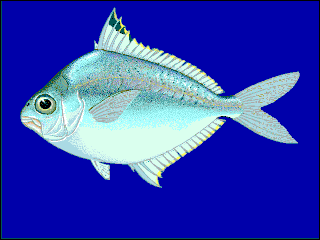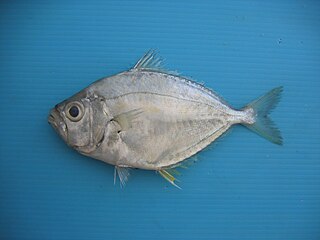Jean-Jacques Dussumier (1792–1883) was a French voyager and merchant from Bordeaux. He is known as a collector of zoological species from southern Asia and regions around the Indian Ocean between 1816 and 1840. These collections were later studied and classified by French zoologists such as Georges Cuvier, Achille Valenciennes, among others.

Deveximentum is a genus of ponyfishes native to the Indian Ocean and the western Pacific Ocean.

The striped ponyfish is a species of marine ray-finned fish, a ponyfish from the family Leiognathidae. It is native to the Indian Ocean and the western Pacific Ocean, from the Red Sea and the eastern coast of Africa to Fiji and Samoa, where it occurs in coastal marine and brackish waters. It occurs at depths of from 20 to 50 metres. It is a predator upon smaller fishes, small crustaceans and polychaete worms. This species grows to a length of 21 centimetres (8.3 in) TL though most do not exceed 17 centimetres (6.7 in) TL. It is of minor importance to local commercial fisheries. This species is the only known member of its genus.

Eubleekeria is a genus of marine ray-finned fishes, ponyfishes from the family Leiognathidae which are native to the Indian Ocean and the western Pacific Ocean.

Karalla is a genus of marine ray-finned fishes, ponyfishes from the family Leiognathidae which are native to the Indian Ocean and the western Pacific Ocean.

Leiognathus is a genus of marine ray-finned fishes, ponyfishes from the family Leiognathidae. They are native to the Indian Ocean and the western Pacific Ocean. They are sometimes known as silverbellies.

Photopectoralis is a genus of marine ray-finned fishes, ponyfish from the family Leiognathidae. They are native to the Indian Ocean and the western Pacific Ocean.

Eubleekeria splendens, common names splendid ponyfish and blacktip ponyfish, is a species of ponyfish.
Photopectoralis aureus, commonly known as the golden ponyfish or false toothed ponyfish, is a marine ray-finned fish native to the Western Pacific from Taiwan south to Indonesia as well as to the Gulf of Thailand, Timor Sea, and the Arafura Sea. It grows to 10 cm (3.9 in) TL. This species was first formally described in 1972 as Leiognathus aureus by the Japanese ichthyologists Tokiharu Abe (1911-1996) and Yata Haneda (1907-1995) with the type locality given as Ambon fish market on Ambon Island. It is the type species of the genus Photopectoralis which was delineated by Sparks, Dunlap & W. L. Smith in 2005.

Leiognathus longispinis, commonly known as the longspine- or Smithurst's ponyfish, is a fish of brackish and marine waters found in the Indian and western Pacific Oceans, from India through Malaysia and Indonesia south to northern Australia and east to the Philippines and Fiji It was described in 1835 by French Zoologist Achille Valenciennes from a specimen caught off Waigeo island in Irian Jaya in New Guinea. In 1886 Ramsay and Ogilby described what turned out to the same species from Hood Lagoon in Papua New Guinea, naming it Leiognathus smithursti. In 2008, ichthyologists Prosanta Chakrabarty and John S. Sparks resurrected the genus Aurigequula and placed L. longispinis and L. fasciatus in it, on the basis of a horizontal row of yellow markings on their flanks and elongated second spine of the dorsal fin. However, a molecular study showed that the genus Leiognathus was nested within Aurigequula, and hence the genera were merged once more. Fishbase places this species in Leiognathus while retaining the striped ponyfish in the monotypic Aurigequula.

Leiognathus equula, the common ponyfish is a species of marine ray-finned fish, a ponyfish from the family Leiognathidae. It occurs in brackish and marine waters from East Africa to Fiji in the Indian and western Pacific Oceans, Red Sea and Persian Gulf.

Karalla daura, the goldstripe ponyfish, black slipmouth, black-finned slipmouth or pugnose pony, is a species of marine ray-finned fish, a ponyfish from the family Leiognathidae. It is native to the Indian Ocean and the western Pacific Ocean, from the Gulf of Aden to the Philippines. It is found in shallow water, mainly over muddy substrates where it normally occurs in schools. Its diet consists of polychaetes, bivalves, small crustaceans and sponges.

Gazza minuta, the toothpony or toothed ponyfish, is a species of marine ray-finned fish, a ponyfish from the family Leiognathidae. It is found in the Indo-Pacific from the Red Sea and the east African coast east through the Indian and Pacific Oceans to Australia and Tahiti north as far as the Ryukyu Islands. It occurs over sandy and silty bottoms, although the young prefer mangroves and silty reefs. it feeds using its protruding pipette-like mouth or using the gill rakers as seives. Its food consists of smaller fishes, crustaceans and polychaetes.

Eubleekeria jonesi, commonly known as Jones’s pony fish, is a marine ray-finned fish, a ponyfish from the family Leiognathidae. It is native to the Indian Ocean. This species was first formally described as Leiognathus jonesi in 1971 by the Indian ichthyologist P.S.B.R. James (1934-2019) and its specific name honours James’ predecessor as director of the Indian Central Marine Fisheries Institute in Kochi, Santhappan Jones (1910-1997).

Photolateralis stercorarius, the oblong slipmouth, is a marine ray-finned fish, a ponyfish from the family Leiognathidae. It has been recorded from Indonesia, Philippines, New Guinea, Guam and Tonga in the western Pacific Ocean. It lives on inner reef flats and in silt-laden inshore waters at depths greater than 20 metres (66 ft). It attains a maximum recorded total length of 10.2 centimetres (4.0 in). It was first formally described in 1907 as known as Leiognathus stercorarius by the American ichthyologists Barton Warren Evermann (1853-1932) and Alvin Seale (1871-1958) with the type locality given as Bulan, Sorsogon in the Philippines. It was more recently named as Equulites stercorarius, but was re-evaluated in 2015 as part of Photolateralis. It is the type species of the genus Photolateralis.

Equulites elongatus, the slender ponyfish, also called the elongate ponyfish, elongate slimy or elongated slipmouth, is a marine fish of the family Leiognathidae native to the western Pacific and Indian Oceans.

Leiognathus brevirostris, commonly known as the shortnose ponyfish, is a ray-finned fish of brackish and marine waters found from Indo-West Pacific to the Indian coasts and off Sri Lanka to China and south of Australia. Like its relatives, the fish is an amphidromous, demersal species which feeds on diatoms, copepods, Lucifer, nematodes and polychaetes. The fish has eight dorsal spines, sixteen dorsal soft rays, three anal spines and fourteen anal soft rays. Fresh specimens possess a golden gleam which fades with dryness.
Equulites klunzingeri, or Klunzinger's ponyfish, is a marine, demersal species of ponyfish from the family Leiognathidae which was originally found only in the Red Sea. It is colonizing the Mediterranean as part of the Lessepsian migration through the Suez Canal.

Deveximentum insidiator or previously Secutor insidiator, the pugnose ponyfish or barred ponyfish, is a species of ray-finned fish, a ponyfish in the family Leiognathidae. The barred ponyfish's mineralized skeleton contains apatite and the mineralized tissue contains hydroxylapatite. They have bare heads with nuchal spines and their bodies are a distinctive, reflective silver, frequently imitated by fishermen using silver lures. They have a protracted mouth pointing upward and the tip of the maxilla reaches well below the level of the lower margin of the eye. Barred ponyfish feed on zooplankton, including larval fishes and crustaceans. Body depth is twice or slightly more than standard length, which measures 11.3 cm from the tip of the snout to last vertebra. The lateral line ends before the dorsal fin.














